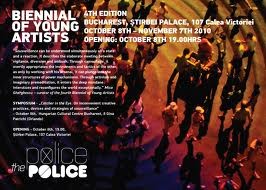The Young Artists' Biennial Bucharest 2010
08 Oct - 07 Nov 2010
Police the Police
8 October – 7 November, 2010
Curator:
Mica Gherghescu
The Biennial of Young Artists’ fourth edition, Bucharest 2010, opens with quite an untranslatable mirroring word pun: “police the police”. There is something tricky in the constructive symmetry of this message and in its automatically imperative stance. It seems to be captured in the net of mere illustrative restriction and second offence imminence. It would be rather superficial, nonetheless, if it went only as a militant and rebellious impetus or as yet another predictable and exhausted form of institutional critique. I would like to give for this year’s theme and exhibition another angle of incidence, modeled by a certain polymorphism, stringently contemporary and ubiquitously felt.
Policing ways of seeing are intimately linked with observance and surveillance strategies, with relationships between the observer and the observed, with points of vision and position, with tracking and targeting techniques, with mingled regulating forms of control, protection and sanction. Seen in these terms, there is some basic epistemological complementariness between police praxis and any visual study or historiography – same decoding phantasms, same morellian inductions, and same indicial reconstructions.
Going farther. I will introduce as a fertile and more indeterminate antiphrasis for the surveillance notion its counter-part concept, “sousveillance”. Launched some time ago by Steve Mann as an accompanying notion for his hybrid cyborg surveillance and mediating extensions, “sousveillance” literally designated a form of “appropriating the tools of the oppressor”, in a fundamental subversion of any Panoptikon logics. More recently and more locally oriented, Rob O’Copp’s Nottingham Office of Community Sousveillance opposes, doubles and thoroughly watches community police officers by registering their sideslips.
I convoke this notion today and I would like to test and confront it in this edition with other chameleonic artistic practices that make use of it in their civic dilemmas. How do artists and cultural activists tackle such a political subject in their work, how do they react in their own counter-observance actions towards authority and control, how do they carry their own investigations, how do they launch speculations, pendulating between “wakefulness” and “watchfulness”? How do they work “under cover” in dreaming of full disclosure?
Reminder. On the local Romanian scene, the “surveillance” history activates in the private and public space and memory long time invasive practices (acquired, hereditary, suffered of or inflicted upon others). Recent cultural productions plunged in and exploited this rich invisible heritage with its recurrent lieux de mémoire. Not to mention the paradigmatic figure of the policeman, subject to so many fictive screenplays, vampirized and mocked, nurturing his duplicities or fearing his versatility. Talking today about “sousveillance” tries to breech revolute lines of thought and reflex associations. It tries to understand the way contemporary cultural practitioners grasp this emblematic figure of control and all its possible disguises, far more diffuse and imperceptible, far more allusive and infiltrative. Local interventions (recent projects as well as historical sparkles) will try to articulate this proposition in collaborating with a wide range of attitudes, situations, objects, discourses and devices, multilayered and spread on various theoretical platforms and different international entry and view points.
Bandwidth. In analyzing Montaigne’s reflections and Walter Benjamin’s “Critique of Violence”, Jacques Derrida was reactivating one oracular saying about those legitimate fictions our law is based on. On another level, one should keep in mind the abundance of heterogeneous visionary inventions deploying in fantasy literature an impressive technical inventory that never ceases to proliferate.
More than activist radicalism, I think of an activist reverie and of giving a fictional, metaphorical indentation to this exhibition. In re-instating an old-time fantasy, could we still dribble power today through a visual “dazzling” reaction?
Participants:
Carla Ahlander – Germany
Maria Luiza Alecsandru – Romania
Artstation (Anne Hayes & Glenn Davidson) – United Kingdom
Marc Bijl – Germany
Zoltan Bela – Romania
Roberto Bellini – Brazil
Neil Beloufa & Dorian Gaudin – France
Levente Benedek – Romania
David Böhm & Jiři Franta- Czech Republic
Emanuel Borcescu – Romania
CHTO DELAT – Russia
Jasmina Cibic – Slovenia
Elena Ciobanu – Romania
Alexandra Croitoru – Romania
Nemes Csaba – Hungary
diSTRUKTURA – Serbia
Uros Djuric – Serbia
Harm van den Dorpel – Netherlands
Aldo Giannotti & Stefano Giuriati – Italy / Austria
Lukasz Gronowski – Poland
Teodor Graur – Romania
Driton Hajredini – Albania / Germany
Nicu Ilfoveanu – Romania
Christoph Wachter & Mathias Jud – Germany / Switzerland
Kasia Krakowiak – Poland
Pavel Kopriva – Czech Republic
Oliver Laric – Germany
Theo Ligthart – Germany
Maxim Liulca – Republic of Moldova / Romania
2 META – Romania
Olivia Mihaltianu – Romania
N55 – Denmark
Vlad Nanca – Romania
Mircea Nicolae – Romania
Blue Noses Group – Russia
Auguste Orts (Herman Asselberghs) – Belgium
Trevor Paglen – USA
George Rasovszky – Romania
Gordan Savicic – Austria
Pascual Sisto – Spain/USA
Surekha – India
Simona Tanasescu – Romania
UBERMORGEN.COM – Austria
Peter Weibel – Austria
Fani Zguro – Albania/Germany
Shadi Habib Allah – USA / Palestine
Carla Cruz – Portugal
Desire Machine Collective (Sonal Jain and Mriganka Madhulaillya) – India
Gaylan Abdullah Ismail – Irak
Chelsea Knight – USA
Oliver Ressler – Austria
Ruti Sela & Maayan Amir – Israel
Jin Shan – China
Mirko Smerdel – Italy
Marie Voignier – France
1000 mm/ or the bedroom window
Lena von Lapschina – Austria
Mirjana Peitler


